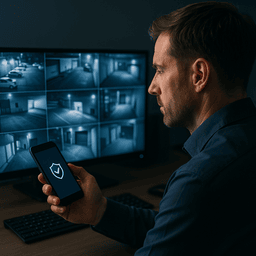
Why after-hours protection matters more than ever for manufacturing facilities
Let’s be honest: for a lot of manufacturing facilities, the surveillance system “does its job” just by recording. Cameras are installed, footage is stored, and someone may (or may not) check it if something goes wrong.
But here’s the reality: most plants are vulnerable after hours, and a passive camera system just isn’t enough anymore.
When your facility is quiet—overnight, over the weekend, or during a shift change—is exactly when the risks go up. Theft. Vandalism. Unsafe conditions. Unverified access. Equipment tampering. And unfortunately, most systems only let you see what happened after the damage is done.
Let’s walk through what your surveillance system should be doing when your people aren’t around—and how to get there.
k
k
Why Passive Surveillance Doesn’t Cut It
Traditional systems rely on human review and manual incident response. That’s fine for documentation, but not for prevention. And when incidents happen after hours, you might not know until hours—or days—later.
Here are the usual gaps:
-
You’re recording, but not actively monitoring
-
There’s no real-time alerting for events like motion, access, or perimeter breaches
-
Surveillance isn’t integrated with your access control or fire systems
-
Your system can’t tell the difference between a raccoon and a real threat
Sound familiar?
k
k
What a Modern Surveillance System Should Be Doing at Night
When your lights are off and the floor is empty, your cameras should still be working for you. Here’s what that looks like.
1. Detecting Activity—Not Just Motion
Modern surveillance uses video analytics and AI to tell the difference between harmless movement and suspicious behavior.
-
A truck pulling into the wrong loading dock after hours? That’s a flag.
-
Someone pacing near a restricted area? That’s not just motion—that’s a potential threat.
-
Your back gate swinging open at 2:47 AM? Definitely worth a closer look.
These systems send real-time alerts based on pre-set conditions, giving you time to act—not just review.
k
k
2. Tied Into Your Access Control System
If a door opens at 3 AM, who opened it? Was it a scheduled cleaning crew or an unauthorized swipe?
With integrated systems:
-
Access control logs are instantly linked to camera footage
-
Doors can lock, unlock, or alert based on security policies
-
You don’t have to guess whether a badge was stolen or shared
It’s not just about monitoring—it’s about context.
k
k
3. Enabling Remote Monitoring
You don’t need someone on-site 24/7. With today’s cloud-based video platforms, your team—or a professional monitoring service—can verify and respond to alerts in real time.
That means:
-
No more false alarms waking up your plant manager
-
Live video feeds accessible from mobile devices
-
Voice-down features to deter intruders remotely (“You are being recorded, please leave the premises.”)
k
k
4. Running Scheduled Virtual Patrols
Your cameras can be set to rotate, zoom, and capture high-risk areas on a schedule—even if no one’s manually operating them.
This is especially useful for:
-
Warehouses storing high-value inventory
-
Facilities with complex layouts or outdoor lots
-
Hazard detection (leaks, fires, blocked exits)
It’s like having a digital guard on patrol all night long.
k
k
Real Example: The Nightshift Mystery
One of our manufacturing clients kept noticing inconsistencies in their packaging line. Equipment would mysteriously go out of calibration, causing delays and wasted material.
They had surveillance cameras—but no alerts, no access integrations, and no one actively watching the footage.
When they finally upgraded to a system with remote monitoring and door-camera integration, the problem became clear: a third-party technician was accessing the building during off-hours and adjusting settings outside of protocol.
That discovery saved the company thousands—and helped them tighten access policies and overnight procedures.
k
k
Key Features You Should Have
If your facility’s surveillance system hasn’t been updated in the last few years, take a look at what’s possible now:
-
AI-powered motion detection and alerts
-
Cloud-based storage with mobile access
-
Event-based camera bookmarks
-
Thermal and infrared imaging
-
Remote talk-down and notification features
-
Direct integration with access control, alarm, and fire systems
The tech exists. The question is—are you using it to its full potential?
k
k
Final Thoughts: It’s Time for Surveillance to Do More
Manufacturing environments are complex. There’s a lot to protect. And chances are, your security risks don’t disappear just because your team clocks out.
Surveillance should give you more than archived footage. It should help you:
-
Prevent incidents
-
Speed up response
-
Reduce downtime
-
Stay compliant
And most importantly—it should give you peace of mind, even when your facility is quiet.
Ready to see how a smarter surveillance system could work for your plant?
Reach out to SSP for a walkthrough of what’s possible, and how it fits your environment, budget, and growth plans.


